Excerpts from Jim Conrad's
Naturalist Newsletter
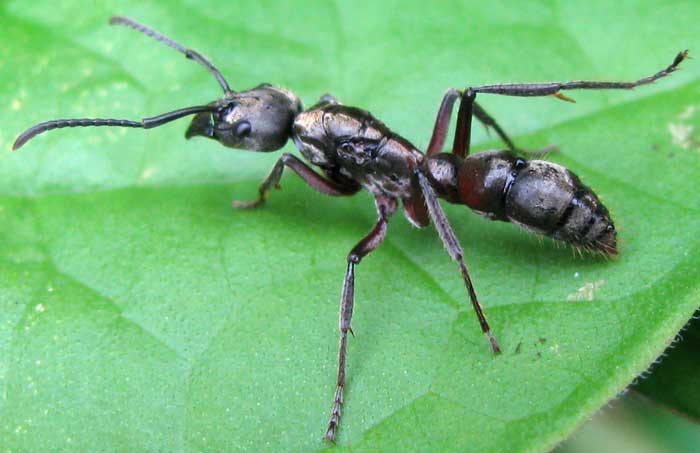
from the November 14, 2010 Newsletter issued from Hacienda Chichen Resort beside Chichén Itzá Ruins, central Yucatán, MÉXICO
JOCH THE PANTHER ANT
Joch (pronounced HOCH, rhyming with poach) first caught my attention soon after I'd arrived here when one day I leaned against a Cedro tree, and thought that a scorpion had stung me. It turned out to be a half-inch long (13mm), hairy, black ant like one shown above.
A couple of days later, as I was putting on a shirt -- which must have had one or more ants in it -- I got a couple more bites. The stings weren't as painful as a wasp's but it was much worse than that of a fire-ant. That's when I began asking the fellows about this big, black, solitary-wandering ant with a powerful sting.
They knew exactly which ant I was talking about, and showed me that they'd walk a good bit out of their way just to stomp one. They called it "Joch," and assured me that Joches climb high into palm trees where they turn into wasps, which eventually beneath the palm fronds build paper nests holding wasp larvae, and those larvae make great eating with a little chili, sour orange and salt...
Well, science says that ants don't turn into wasps that build paper nests, so I just filed that information. I figured I'd never find out the Joch's technical name, which I'd need if I were to look it up and see what the Joch's real story was.
I did, however, find reference to what only could have been Joches in Friar Diego de Landa's book Relación de las cosas de Yucatan, written in 1566 soon after the Conquest. He writes:
There is a kind of large ant whose bite is very bad, and which pains and suppurates more than that of the scorpions, and lasts twice as long, as I know by experience.
Though my bites never suppurated, they did hurt like the dickens, and stay red much longer than a bee or wasp sting would have.
And then this week on the Internet I had the luck to blunder upon a forum for German-speaking ant enthusiasts, at http://www.ameisenforum.de -- "Ameise" being German for "ant." I uploaded the above photo to the forum and by the next day I had a verdict: It's a queen of the genus Pachycondyla. Elsewhere I read that PACHYCONDYLA VILLOSA is common in the Yucatán, and pictures of that species match ours, so tentatively that's what I'm calling it. A common name in English for Pachycondyla villosa is Hairy Panther Ant.
Hairy Panther Ants are widely distributed in lowlands from southern Texas to northern Argentina. They're described as generalized arboreal predators, preying on many kinds of arthropods. I've seen them enter and leave small cavities in dead tree limbs and trunks, and I read that they'll nest in almost any cavity, including hollow Cecropia trunks. J.B. Heinze and others write in the Journal of Insect Behavior:
Workers in queenless groups of the ant Pachycondyla villosa engage in antennal boxing and biting and by these interactions establish social dominance hierarchies, in which several high-ranking individuals may lay eggs. We observed egg cannibalism by dominant workers.
Often I've noted Joches carrying clear droplets of liquid in their mandibles as they roamed about. Now I read that workers of this species harvest nectar and carry it exactly as I've seen, later to share it with other workers, and larvae.
from the August 21, 2016 Newsletter issued from Hacienda Chichen Resort beside Chichén Itzá Ruins; limestone bedrock; elevation ~39m (~128ft), N20.675°, W88.569°; central Yucatán state, MÉXICO
BETTER PHOTO
At the edge of an ant stream invading the hut and attacking a paper wasp nest, there was a much larger ant seemed sick or confused, not moving as fast. This larger ant possessed substantial "pincers," or mandibles, and a much broader head to accommodate muscles to enable the mandibles to bite down hard, for this was a soldier, shown below:
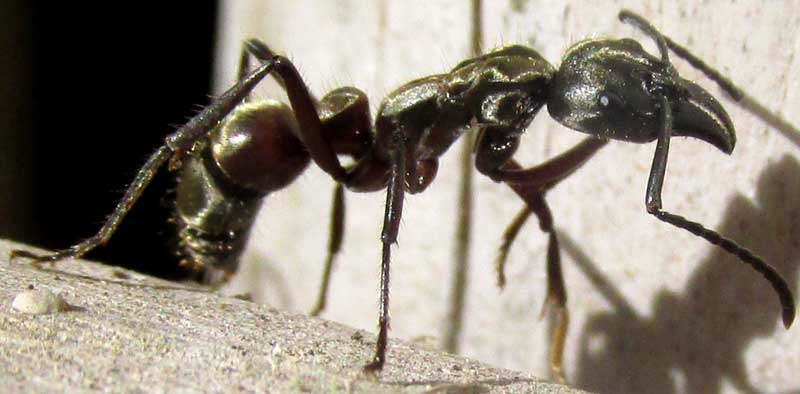
It was a Hairy Panther Ant, maybe not sock or confused, but just surveying things to see if she could get some booty herself.
from the December 20, 2015 Newsletter issued from Hacienda Chichen Resort beside Chichén Itzá Ruins, central Yucatán, MÉXICO
PANTHER ANT ON A HELICONIA
A Heliconia plant beside the hut door is preparing to flower now, its first orange-yellow bracts just emerging atop big, glossy-green leaves. You can review what Heliconias look like at www.backyardnature.net/yucatan/heliconi.htm.
As soon as a bright splotch of orangish yellow developed atop the Heliconia, a Joch, or Hairy Panther Ant, moved onto the spot and stayed -- hour after hour, day after day. As the Heliconia developed, the Joch remained, though sometimes he'd disappear for two or three days, then one morning there he'd be again, in the same spot as always, as shown below:
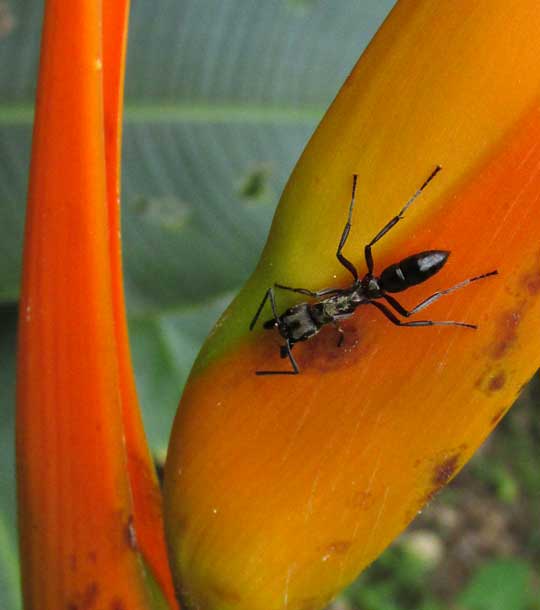
Notice that his mandibles are wide open. It's easy to figure out that this Joch -- Joches are described in the literature as "generalized arboreal predators, preying on many kinds of arthropods" -- is just waiting for the Heliconia's splash of color to attract a pollinator, so he can attack and eat it.
A closer look at the hairy-legged Joch, stealthily peeping over the side of his platform, presumably to see if prey is at hand, is shown below:
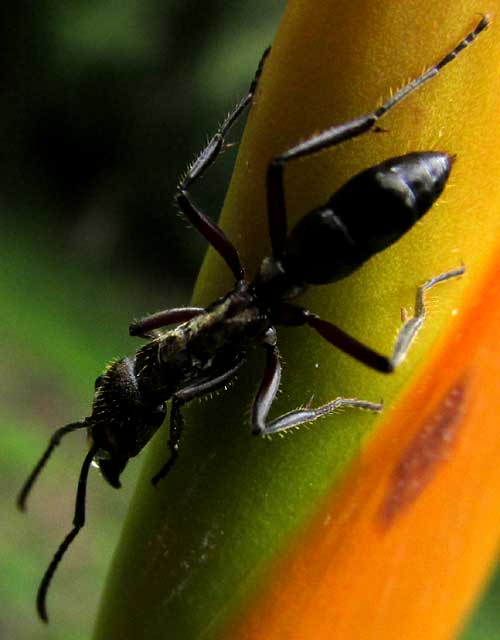
When a pollinator approaches or lands, the Joch moves in slowly. I've not seen him capture prey yet, though.
from the June 26, 2016 Newsletter issued from Hacienda Chichen Resort beside Chichén Itzá Ruins, central Yucatán MÉXICO
A JOCH NEST DISCOVERED
This week I learned for sure where some Joch live, the hard way.
Recent rain had softened and loosened bark on a Piich tree's large, dead limb, on which grew a veritable garden of epiphytic plants, especially bromeliads and aroids. A whole cluster of big bromeliads, Aechmea bracteata, large enough to fill a bathtub, had fallen to the ground, and I decided to drag them to the hut, set them upright, water them daily, and eventually maybe they'd grow into something pretty. below, you can see the bromeliads in question, still attached to a portion of their rotten Piich branch, lying where they fell:

As I began dragging the heavy cluster, it was as if bees or wasps were stinging all over my body, and then I saw that Joches were swarming from a hole in the rotten branch, onto my body. I had to pull them off individually, because simply brushing them away just didn't work.
Once I was Joch free I could see that not only biting Joches were exiting the hole, but also Joches carrying white pupae. The whole nest was abandoning ship.
So, that's where Joch's nest -- in tree cavities, even rotten ones covered with bromeliads.
from the August 9, 2018 Newsletter issued from Rancho Regenesis in the woods ±4kms west of Ek Balam Ruins; elevation ~40m (~130 ft), N~20.876°, W~88.170°, central Yucatán, MÉXICO
PANTHER ANTS CARRYING DROPLETS
A colony of Hairy Panther Ants has set up residence somewhere in the hut's thatch roof. They don't bother me at all. In fact, each morning at dawn as I eat my granola I enjoy watching workers traverse the wire fence that keeps the dogs and me from plunging into the deep pit below us.
On the rusty fence, workers travel alone, and maybe one passes every five minutes, going one direction or another. Those leaving the nest carry nothing in their mandibles, but those approaching always carry either what looks like wads of butchered small invertebrate animals or, about half the time, glistening droplets of liquid, such as seen below:
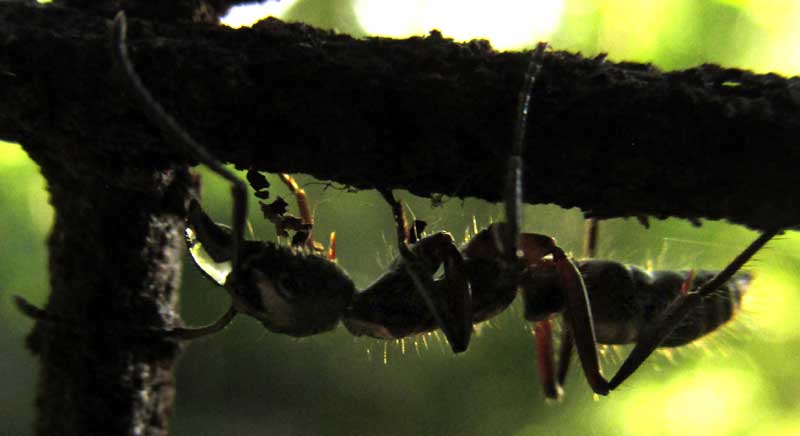
At first I assumed the droplets were water, possibly gleaned from morning dew or my washbasin, but reviewing our page I see that they're known to harvest nectar to share with other workers, and larvae in the nests, so it well may be nectar instead.
In fact, I've seen two panther ants meet on the fence and it looked as if the one leaving the nest touched the droplet the other was carrying, possibly ingesting some of it, but not much.